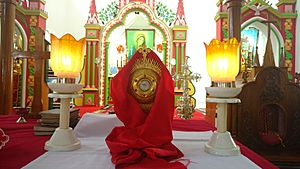Ettu Nombu facts for kids
Quick facts for kids 8 Day Lent |
|
|---|---|
Icon of the Virgin Mary.
|
|
| Also called | Ettu Nombu |
| Begins | 1 September |
| Ends | 8 September |
| Date | Lua error in Module:Wikidata at line 132: attempt to index field 'wikibase' (a nil value). |
| Frequency | Annual |
Ettu Nombu (Malayalam: എട്ടു നോമ്പ്), also known as the Eight Day Lent of Mary, mother of Jesus, is a special time for Christians in Kerala, India. It's a way to remember and honor Mary, the mother of Jesus.
During this time, people observe a period of fasting and praying for eight days. This tradition is followed by many Christian groups in Kerala. These include the Oriental Orthodox churches (like the Jacobite and Indian Orthodox) and Eastern Catholic churches (like the Syro-Malabar and Syro-Malankara Catholic churches).
The eight-day period is observed from September 1st to September 8th each year. Churches hold special services and events to honor Mary. People also do good deeds and attend religious gatherings. For Catholics, praying the rosary together is a common practice. Even though it's not a rule for the whole Church, this tradition is very important to Syrian Christians in India and some other countries.
How Ettu Nombu Began
The practice of Ettu Nombu seems to have started a long time ago. It might be linked to a difficult time for Christians in Kodungallur, a Christian center in Kerala. There are a few stories about how this special lent began.
The Story from Bar Ebroyo
A writer named Bar Hebraeus shared a story from the seventh century. There was a Christian town called Heera near Basra. The ruler of Baghdad took over this town. He sent a strict governor who followed all his orders. The ruler was known to be harsh and liked beautiful women. He was very interested in the women of Heera. He decided to visit the town in three days.
The women of Heera were worried about their safety and honor. They went to the church of St. Mary for help. The priest announced a strict three-day fast. They prayed to Mother Mary to protect them. On the third day, during the church service, a bright golden light filled the church. It is said that the priest saw Mother Mary. She told him, "Do not be afraid; peace be to you – Rejoice. The ruler is no more. Your troubles are over." The priest then told the people the good news. Everyone praised God and thanked Mary for her help.
After this event, the women decided to observe a special lent for eight days. This was from September 1st to September 8th. They believed that Mother Mary had protected their honor and dignity.
Ettu Nombu in Kerala
The tradition of Ettu Nombu spread to India over time. In the 3rd century, a bishop named St. David came to India from Basra. He shared the Christian faith with people. Later, in the 4th century, a group called the Knanaya migrated from Şanlıurfa. More people from Iraq came in the 8th century and helped spread this tradition further.
Since this eight-day lent is not a rule for the entire Church calendar, its popularity varies. However, St. Mary's Cathedral, Manarcaud, which belongs to the Malankara Jacobite Syrian Orthodox Church, is thought to be the first church to widely observe this lent again. It is still the largest church where the 8-Day lent is a very popular tradition.
Old stone writings found at the church show it was built over a thousand years ago. Archaeologists found these writings on memorial stones from 910 A.D. and 920 A.D. They are written in old Malayalam and Tamil scripts. St. Mary's Church, Meenangadi was the first church in the Malabar region to adopt the 8-day lent. Many other churches named after St. Mary have also started observing this special time. On the eighth day, a holy relic called the Holy Girdle is often shown to the public.


